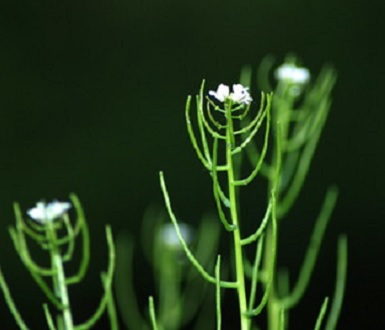GET TO KNOW
Garlic Mustard
In its native range across Europe, garlic mustard is a welcome wildflower.
A NOT-Fun Fact: Strongly flavored plants (such as garlic mustard) that invade cow pastures create problems for dairy farmers. The spicy flavor of various plants in the onion and garlic families is known to affect the flavor of milk produced by cows that eat significant quantities of the plants. Somehow, “garlic milk” just doesn’t sound appealing.
There, it is a common culinary spice, a source of pollen and nectar for local bees, a host plant for the lovely orange-tip butterfly, a food source for many animals, and a natural component of forest flora. Unfortunately, here in North America, it is an invasive – and very aggressive – species that colonizes our native woodlands.
Garlic mustard was introduced to North America long ago. European settlers, who valued its spicy taste, antiseptic properties, and – most unfortunately, its ability to spread and control erosion – carried the plant across the ocean and then across the continent. Today, the garlic mustard invasion reaches all the way from New England to the forests of Oregon and western Canada.
Garlic mustard is classified as an invasive “species of concern” by the State of Michigan and should be reported/removed when found. Conservation groups, including FOTR, regularly organize efforts to pull and remove garlic mustard in the spring before it goes to seed. Last year, during the 2020 Rouge Rescue, volunteers pulled and removed an estimated 790 gallons (measured in terms of garbage bag size) of garlic mustard and other invasive vegetation from our watershed.
PLANT LIFECYCLE
While garlic mustard prefers moist soil in a partially shaded location, it is a tough and hardy plant that can survive a wide range of growing conditions including forests, floodplains, roadsides, and agricultural fields. And, once garlic mustard becomes established in a location, it is almost impossible to eradicate.
As a biennial, garlic mustard has a two-year growth cycle. In its first year, a new plant produces a rosette of small leaves that grow no more than 8” tall. Then, during the spring of its second year, the plant produces a single flower stalk that grows up to 3 ft tall with heavily toothed, heart-shape leaves. Stalks may branch, and each branch develops a cluster of small (4 petal) white flowers that bloom in early spring.
Each branch also develops a number of long, thin seedpods (called siliques) that ripen and burst open to scatter hundreds (or thousands) of tiny seeds in summer. And, just like the parent plant, garlic mustard seeds are hardy.
While this plant spreads only by seed, the tiny seeds are easily transported by wind, water, and animals. Additionally, the seeds – which undergo an initial year of dormancy – may survive up to five years before taking root and sprouting.
KEYS TO INVASIVE SUCCESS
Within its native European range, populations of garlic mustard are kept in balance by a variety of natural enemies. Various mammals / rodents and some 69 different insects feed heavily on the plants. Consequently, garlic mustard plants peacefully coexist in European forests as part of a properly functioning food web.
In North America, garlic mustard has few natural enemies. Local grazing mammals (such as white-tailed deer) and rodents prefer to munch on their favorite native plants while trying to avoid garlic mustard. Likewise, only a few native insect species are found to actively consume the plant. Researchers believe that grazing mammals carry garlic mustard seeds on their fur. Then, while feeding, the animals inadvertently plant garlic mustard seeds in place of the native plants being consumed. The unfortunate result is that the more deer graze, the more they spread a plant they don’t even want to eat.
Some native butterflies – such as the Virginia white (Pieris virginiensis) and the mustard white (Pieris oleracea) – normally lay their eggs on local versions of mustard and toothwort plants. Unfortunately, these butterflies can be confused by the presence of garlic mustard. They mistakenly lay their eggs on it, but it is not actually edible for their caterpillars. This has resulted in severe population declines of both species.
Another potential suspect contributing to garlic mustard’s success is the earthworm. Earthworms are not native to Michigan. Research indicates that the introduction of earthworms to Michigan forests (by fisherman, campers, and general human interference) leads to an excessively rapid deterioration of the natural leaf litter on the forest floor. This reduction of leaf litter, in turn, changes the physical and chemical composition of the forest floor in ways that harm many native understory plants (such as spring ephemerals). The corresponding die-off of understory plants creates a “hole” in the fabric of the forest that garlic mustard opportunistically fills.
TAKE ACTION
You can help protect and restore the Rouge River watershed by fighting the spread of invasive plants. FOTR works to remove garlic mustard (and other invasive vegetation) during annual clean-up events including our upcoming Rouge Rescue on May 15th. Join us at one of our many worksites across the watershed to clean-up trash, remove invasive plants, and install native plants.
For More Information On Invasive Species Register for a Rouge Rescue Event! Get Out on Your Own for Rouge Rescue!NOTE: Spring is the easiest time of year to properly identify and remove garlic mustard plants. In order to properly remove garlic mustard plants, please follow the following steps:
- Remove mature (second year) plants when they have flowers – but before seed pods are fully developed.
- Pull, or dig, at the base of the plant in order to remove the entire root.
- Bag pulled plants and properly dispose of the bags. (Do not compost the plants because the seeds may still ripen and spread.) You can also dry out the plants and then burn them (be careful though!)
MAIN PHOTO CREDIT: Garlic Mustard (Alliaria petiolate) – photos by: Joshua Mayer CC-BY-SA-2.0 (2 close-ups) and “c “– Public Domain (last picture) – IMAGES CROPPED


